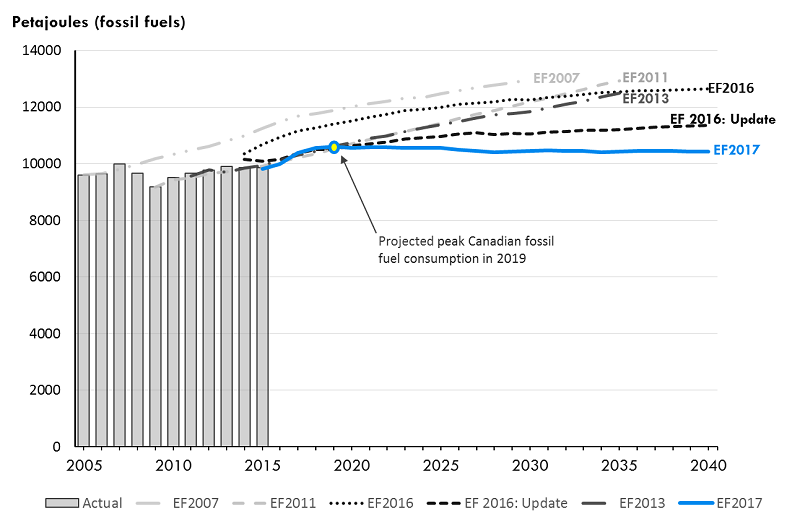Market Snapshot: Canada expected to use less fossil fuels starting in 2020
Release date: 2017-11-01
The NEB projects that Canada will soon begin decreasing its use of fossil fuels. The NEB has been estimating energy supply and demand for 50 years, and the use of fossil fuels has always been expected to keep increasing. The NEB’s most-recent report, Canada’s Energy Future 2017: Energy Supply and Demand Projections to 2040 (EF2017), projects Canadian fossil fuel consumption will peak in 2019. After that, fossil fuel use is expected to decline gradually in the Reference Case. This is mainly due to lower use of coal and refined petroleum products in Canada.
Canadian fossil fuel use projections from recent Energy Futures reports
Source and Description
Source: Canada’s Energy Future 2017: Energy Supply and Demand Projections to 2040
Description: This column and line chart illustrates historic Canadian fossil fuel consumption in columns. Overlaid is a line chart that illustrates the projected future fossil fuel consumption of EF reports from EF2007 to EF2017. Historic consumption fluctuated at levels just under 10 000 petajoules of fossil fuel consumption, except for 2007, where consumption peaked at just over 10 000 petajoules. The projections from EF2007 to 2016 show an increasing trend in fossil fuel consumption but in most cases this trend line became lower than it was in the previous projection. The projection from EF2017, which is the NEB’s Reference Case, shows increasing fossil fuel consumption until 2019, which peaks at 10 611 petajoules, then a very gradual decline from 2020 to 2040.
Fossil fuel use is expected to decrease for many reasons. New technology and recent emissions policies are key. The Pan-Canadian approach to pricing carbon pollution provides an incentive to reduce demand for fossil fuels. In the transportation sector, green house gas emission standards for vehicles produced after 2018 results in lower gasoline and diesel demand growth. The number of electric vehicles will increase due to policy incentives, especially in Quebec [French only] and Ontario. This will reduce the need for gasoline in passenger vehicles. In the oil production sector, the steam to oil ratio for in-situ oil sands production improves more quickly than in previous EF projections. This reduces demand for natural gas to produce steam for oil extraction. This change is partly due to the use of steam-solvent technology for in situ recovery. The electricity sector is phasing-out coal fired generation; by 2040 wind capacity is projected to double and solar capacity to triple. Also, lower estimates for economic and population growth lead to lower fossil fuel demand.
- Date modified:

